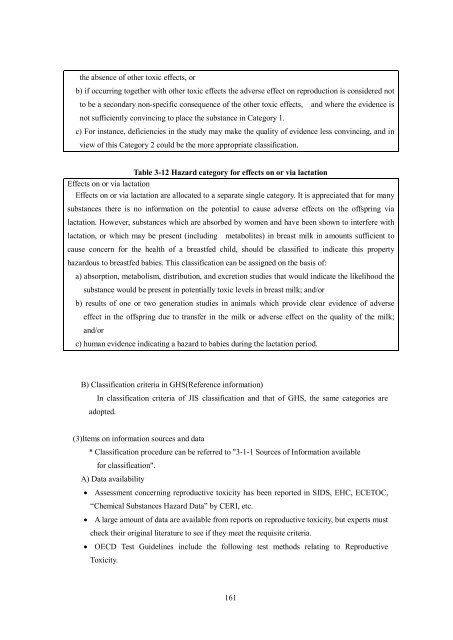GHS Classification Guidance for the Japanese Government
GHS Classification Guidance for the Japanese Government
GHS Classification Guidance for the Japanese Government
Create successful ePaper yourself
Turn your PDF publications into a flip-book with our unique Google optimized e-Paper software.
<strong>the</strong> absence of o<strong>the</strong>r toxic effects, or<br />
b) if occurring toge<strong>the</strong>r with o<strong>the</strong>r toxic effects <strong>the</strong> adverse effect on reproduction is considered not<br />
to be a secondary non-specific consequence of <strong>the</strong> o<strong>the</strong>r toxic effects, and where <strong>the</strong> evidence is<br />
not sufficiently convincing to place <strong>the</strong> substance in Category 1.<br />
c) For instance, deficiencies in <strong>the</strong> study may make <strong>the</strong> quality of evidence less convincing, and in<br />
view of this Category 2 could be <strong>the</strong> more appropriate classification.<br />
Table 3-12 Hazard category <strong>for</strong> effects on or via lactation<br />
Effects on or via lactation<br />
Effects on or via lactation are allocated to a separate single category. It is appreciated that <strong>for</strong> many<br />
substances <strong>the</strong>re is no in<strong>for</strong>mation on <strong>the</strong> potential to cause adverse effects on <strong>the</strong> offspring via<br />
lactation. However, substances which are absorbed by women and have been shown to interfere with<br />
lactation, or which may be present (including metabolites) in breast milk in amounts sufficient to<br />
cause concern <strong>for</strong> <strong>the</strong> health of a breastfed child, should be classified to indicate this property<br />
hazardous to breastfed babies. This classification can be assigned on <strong>the</strong> basis of:<br />
a) absorption, metabolism, distribution, and excretion studies that would indicate <strong>the</strong> likelihood <strong>the</strong><br />
substance would be present in potentially toxic levels in breast milk; and/or<br />
b) results of one or two generation studies in animals which provide clear evidence of adverse<br />
effect in <strong>the</strong> offspring due to transfer in <strong>the</strong> milk or adverse effect on <strong>the</strong> quality of <strong>the</strong> milk;<br />
and/or<br />
c) human evidence indicating a hazard to babies during <strong>the</strong> lactation period.<br />
B) <strong>Classification</strong> criteria in <strong>GHS</strong>(Reference in<strong>for</strong>mation)<br />
In classification criteria of JIS classification and that of <strong>GHS</strong>, <strong>the</strong> same categories are<br />
adopted.<br />
(3)Items on in<strong>for</strong>mation sources and data<br />
* <strong>Classification</strong> procedure can be referred to "3-1-1 Sources of In<strong>for</strong>mation available<br />
<strong>for</strong> classification".<br />
A) Data availability<br />
Assessment concerning reproductive toxicity has been reported in SIDS, EHC, ECETOC,<br />
“Chemical Substances Hazard Data” by CERI, etc.<br />
A large amount of data are available from reports on reproductive toxicity, but experts must<br />
check <strong>the</strong>ir original literature to see if <strong>the</strong>y meet <strong>the</strong> requisite criteria.<br />
OECD Test Guidelines include <strong>the</strong> following test methods relating to Reproductive<br />
Toxicity.<br />
161
















